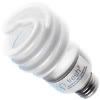The new cool
Posted by
Unknown
The product is the compact fluorescent lightbulb, a quirky-looking twist of frosted glass. In the energy business, it is called a "CFL," or an "energy saver." One scientist calls it an "ice-cream-cone spiral," because in its most-advanced, most-appealing version, it looks like nothing so much as a cone of swirled soft-serve ice cream.
Check out this little fact on them.
One thing hasn't changed: the energy savings. Compact fluorescents emit the same light as classic incandescents but use 75% or 80% less electricity.
What that means is that if every one of 110 million American households bought just one ice-cream-cone bulb, took it home, and screwed it in the place of an ordinary 60-watt bulb, the energy saved would be enough to power a city of 1.5 million people. One bulb swapped out, enough electricity saved to power all the homes in Delaware and Rhode Island. In terms of oil not burned, or greenhouse gases not exhausted into the atmosphere, one bulb is equivalent to taking 1.3 million cars off the roads.
How it works.
A "normal light bulb" is also known as an incandescent light bulb. These bulbs have a very thin tungsten filament that is housed inside a glass sphere. They typically come in sizes like "60 watt," "75 watt," "100 watt" and so on.
The basic idea behind these bulbs is simple. Electricity runs through the filament. Because the filament is so thin, it offers a good bit of resistance to the electricity, and this resistance turns electrical energy into heat. The heat is enough to make the filament white hot, and the "white" part is light. The filament glows because of the heat -- it incandesces.
The problem with incandescent light bulbs is that the heat wastes a lot of electricity. Heat is not light, and the purpose of the light bulb is light, so all of the energy spent creating heat is a waste. Incandescent bulbs are therefore very inefficient. They produce perhaps 15 lumens per watt of input power.
A fluorescent bulb uses a completely different method to produce light. There are electrodes at both ends of a fluorescent tube, and a gas containing argon and mercury vapor is inside the tube. A stream of electrons flows through the gas from one electrode to the other (in a manner similar to the stream of electrons in a cathode ray tube). These electrons bump into the mercury atoms and excite them. As the mercury atoms move from the excited state back to the unexcited state, they give off ultraviolet photons.
The thing I find fascinating is on each package you see the output (60, 75, 100 watt). The amount of electricity for the regular bulb output is more than these new fluorescent bulbs. This is the main thing that sold me. Plus the bulbs last either 5 or years, dependant on what you buy.
Currently we changed out our office, living room and kitchen. Kel noticed the 60 watt bulbs having a yellow hue to them (I didn't notice). The 100 watts are Kel's favorite. We have them placed in the living room. I have 75 watts in the kitchen and office. Just be sure not to look straight at them. They are bright!

Subscribe to:
Post Comments (Atom)


11:54 AM
Congrats on taking the plunge with compact fluorescent lights! They come in lots of shapes, colors, and brightness levels these days - check our searchable guide to get a sense of the variety. You can definitely see some big savings stack up over the long haul by switching your old lights.
3:19 PM
I have been impressed with them so far, and they don't give off the normal flickrs that could trigger seizures like flouresent lites did at school
3:35 PM
We used them in the kitchen but I have to say they didn't last 5 years lol. Maybe three
6:13 PM
Well 3 beats our 6 month revolution.
I have them in our bedroom as well now. : )
Post a Comment